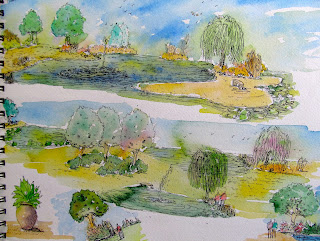 |
| (C) 2015 Dale DiMauro |
Most of September we have had beautiful, clear, sunny days here in Vermont. I paddled with a group from the Brattleboro Outing Club on September 16, at Tully Lake and Long Pond in Royalston, MA. This trip was about an hour from Brattleboro, Vt. We even portaged along the way and hiked to several impressive waterfalls.
I recently started two watercolors inspired from kayaking in this great setting. There was a paddler with us, depicted above in a small sketch, with a new canoe which only weighs eighteen pounds and is the size of a kayak. It even has foot pegs.
After this outing, I started a full sheet watercolor (22" x 30") on Arches 300 lb. watercolor paper and a smaller painting on a 140 lb. 14'" x 20" Saunders block. For me the two surfaces are very different. The Saunders watercolor block is like painting on silk. It is very smooth paper, which the paint brush glides over. In contrast, the Arches sheet has much texture, which allows for a wide range of effects that I am yet to master, but I do like the greater scale.
The above sketchbooks, manufactured by Strathmore, with a fine tooth surface, I have taken a liking to, at least for pencil.









